一般现在时用法讲解及习题教案
- 格式:doc
- 大小:59.00 KB
- 文档页数:7

一般现在时:一、定义与讲解:一般现在时表示经常或习惯性的动作或一般性事实。
,也可表示现在的状态或主语具备的性格和能力。
通常与副词every day(每天),always(总是),usually(通常),often (经常)sometimes(有时),等时间状语连用。
例:(1)表示事物或人物的特征、状态。
The sky is blue.天空是蓝色的。
Mary’s father is an English teacher. 玛丽的爸爸是一名英语老师。
(2)表示经常性或习惯性的动作。
I get up at six every day.我每天六点起床。
She plays sports every day. 她每天都做运动。
(3)表示客观现实。
The table has four legs.桌子有四条腿。
There are 50 students in my class. 我们班有50个学生。
(4)表示客观真理,科学原理,自然现象,等客观事实或格言谚语等。
The sun rises in the east every day.太阳每天从东方升起。
The earth goes around the sun.地球绕着太阳转。
(5)表示平日的喜好。
I like bananas. We don’t like vegetables.He likes ice cream. She doesn’t like strawberries.二.只有主语在第三人称单数时用动词的“三单形式”,其他人称用动词原形。
★动词三单形式的变化规则:1.(1)多数直接在动词词尾加-s.play — plays like — likesask---asks work---works get---gets call---calls(2)以字母s, x, ch, sh或o结尾的动词,在词尾直接加-es.watch---watches wish---wishes do---does go---goes (3)以“辅音字母加 - y”结尾的动词,要先变y为i再加-es.try---tries study---studies cry---cries fly---flies2.不规则变化:be---- is have----has三、一般现在时的句子转换:(1)变一般疑问句:当句子中有be动词或情态动词时,则把be动词或情态动词(can,could等)提到主语的前面,(口诀:一调二变三问号);(2)变否定句:在be动词或情态动词后面直接加not变成否定句. (be后not 莫忘记)例:①陈述句:She is my sister..疑问句→ Is she your sister? Yes, I am./ No, I’m not.否定句→ She is not my sister.②陈述句:I can play soccer.疑问句→ Can you play soccer? Yes,Ican./ No, I can’t.否定句→ I can not /can’t play soccer.★注意:对一般疑问句的回答:一般用什么问就用什么来回答。

一、教学目标:1. 让学生掌握一般现在时的概念和用法。
2. 能够正确运用一般现在时描述经常发生的动作或存在的状态。
3. 提高学生的英语听说读写能力。
二、教学内容:1. 一般现在时的定义和构成。
2. 一般现在时的用法。
3. 一般现在时的句子结构。
三、教学重点与难点:1. 教学重点:一般现在时的概念、构成和用法。
2. 教学难点:一般现在时的句子结构和动词形式的变化。
四、教学方法:1. 任务型教学法:通过完成各种任务,让学生在实践中学习和运用一般现在时。
2. 情景教学法:创设各种情境,让学生在真实的环境中感受和理解一般现在时。
3. 互动式教学法:引导学生积极参与,进行师生互动、生生互动,提高学生的参与度和积极性。
五、教学步骤:1. 引入:通过提问,引导学生思考一般现在时的概念。
2. 讲解:讲解一般现在时的定义、构成和用法。
3. 示例:给出典型的一般现在时的句子,让学生观察和理解。
4. 练习:让学生进行一般现在时的句子仿写和填空练习。
5. 反馈:对学生的练习进行点评和指导,纠正错误,巩固成果。
6. 扩展:通过听力、口语、阅读和写作等多种形式,让学生进一步巩固一般现在时的运用。
7. 总结:对本节课的内容进行总结,强调一般现在时的关键点。
8. 作业布置:布置有关一般现在时的练习题,让学生课后巩固。
9. 课后反思:对课堂教学进行反思,总结优点和不足,为下一步教学做好准备。
10. 教学评价:通过课后作业、课堂表现和考试成绩等多种途径,对学生的学习情况进行评价。
六、教学资源:1. 教材:英语课本及相关辅导资料。
2. 课件:一般现在时的PPT课件。
3. 练习题:一般现在时的练习题及答案。
4. 教学工具:黑板、投影仪、录音机等。
七、教学评价:1. 课后作业:检查学生对一般现在时的理解和运用。
2. 课堂表现:观察学生在课堂上的参与程度、听说读写能力的发挥。
3. 考试成绩:评估学生在测试中的一般现在时掌握情况。
八、教学进度安排:1. 第1周:讲解一般现在时的概念和用法。

一般现在时I: The Present Simple Tense 一般现在时表示经常发生的动作或经常存在的状态.常和 always, often, usually, every day, sometimes等表示时间的状语连用.动词be:除第一人称单数(I)用am,第三人称单数用is外,其余一律用are.行为动词:除第三人称单数做主语时由动词原形加词尾-s或-es外,其余一律用动词原形.现将动词be, 和行为动词(以know为例)在肯定、否定、一般疑问和简略回答中的形式列表如下:表一动词肯定否定be I am …You are …He /She/It is …We /You/They are …I am not …You are not …He /She/It is not …We /You/They are not…行为动词know I /You know …He /She/It knows …We /You/They know …I /You do not know …He /She/It does not knows …We /You/They do not know …表二动词一般疑问简略回答be Are you …?Is he …?Are they …?Yes, I am.No, I am not.Yes, we are.No, we are not.Yes, he is.No, he is not.Yes, they are.No, they are not.行为动词know Do you know …?Does he know …?Do they know …?Yes, I do.No, I do not.Yes, we do.No, we do not.Yes, he does.No, he does not.Yes, they do.No, they don’t.练习:请写出以上两句的一般疑问句和简略回答。
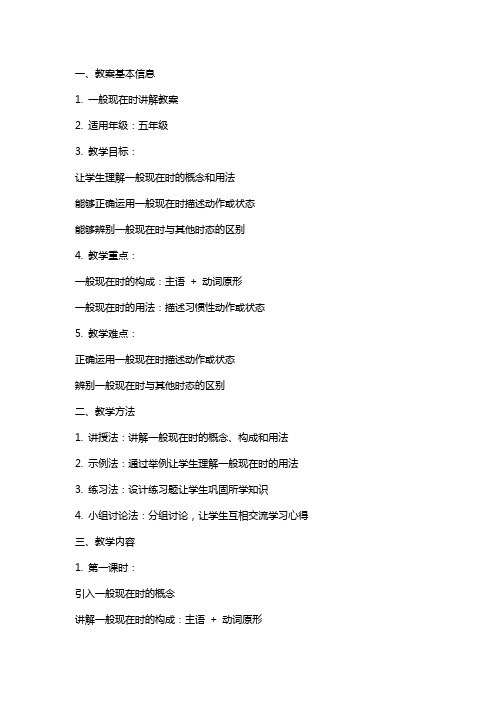
一、教案基本信息1. 一般现在时讲解教案2. 适用年级:五年级3. 教学目标:让学生理解一般现在时的概念和用法能够正确运用一般现在时描述动作或状态能够辨别一般现在时与其他时态的区别4. 教学重点:一般现在时的构成:主语+ 动词原形一般现在时的用法:描述习惯性动作或状态5. 教学难点:正确运用一般现在时描述动作或状态辨别一般现在时与其他时态的区别二、教学方法1. 讲授法:讲解一般现在时的概念、构成和用法2. 示例法:通过举例让学生理解一般现在时的用法3. 练习法:设计练习题让学生巩固所学知识4. 小组讨论法:分组讨论,让学生互相交流学习心得三、教学内容1. 第一课时:引入一般现在时的概念讲解一般现在时的构成:主语+ 动词原形举例说明一般现在时的用法:描述习惯性动作或状态2. 第二课时:通过示例让学生进一步理解一般现在时的用法讲解一般现在时与其他时态的区别(一般过去时、一般将来时)设计练习题,让学生辨别一般现在时与其他时态3. 第三课时:讲解一般现在时的否定句:主语+ do/does/did not + 动词原形讲解一般现在时的疑问句:do/does/did + 主语+ 动词原形设计练习题,让学生运用一般现在时的否定句和疑问句4. 第四课时:讲解一般现在时的被动语态:主语+ am/is/are + 过去分词举例说明一般现在时被动语态的用法设计练习题,让学生运用一般现在时的被动语态5. 第五课时:复习一般现在时的概念、构成和用法设计综合练习题,让学生全面运用一般现在时总结本节课时内容,布置课后作业四、教学评价1. 课后作业:检查学生对一般现在时的掌握程度2. 课堂练习:观察学生在练习中的表现,及时发现问题并进行针对性地讲解3. 小组讨论:评估学生在讨论中的参与程度和理解程度五、教学资源1. PPT课件:展示一般现在时的概念、用法、例子等2. 练习题:设计不同难度的练习题,巩固学生对一般现在时的掌握3. 小组讨论材料:提供相关话题,让学生进行小组讨论六、教学延伸活动1. 制作时间胶囊:让学生设想自己五年后的样子,用一般现在时描述自己的状态和习惯,将纸条放入时间胶囊中,约定五年后打开。
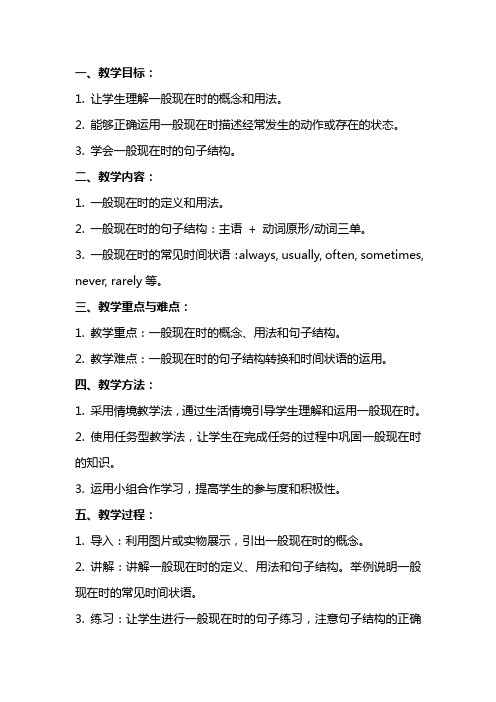
一、教学目标:1. 让学生理解一般现在时的概念和用法。
2. 能够正确运用一般现在时描述经常发生的动作或存在的状态。
3. 学会一般现在时的句子结构。
二、教学内容:1. 一般现在时的定义和用法。
2. 一般现在时的句子结构:主语+ 动词原形/动词三单。
3. 一般现在时的常见时间状语:always, usually, often, sometimes, never, rarely等。
三、教学重点与难点:1. 教学重点:一般现在时的概念、用法和句子结构。
2. 教学难点:一般现在时的句子结构转换和时间状语的运用。
四、教学方法:1. 采用情境教学法,通过生活情境引导学生理解和运用一般现在时。
2. 使用任务型教学法,让学生在完成任务的过程中巩固一般现在时的知识。
3. 运用小组合作学习,提高学生的参与度和积极性。
五、教学过程:1. 导入:利用图片或实物展示,引出一般现在时的概念。
2. 讲解:讲解一般现在时的定义、用法和句子结构。
举例说明一般现在时的常见时间状语。
3. 练习:让学生进行一般现在时的句子练习,注意句子结构的正确性。
4. 任务:布置一道生活情境题,让学生运用一般现在时完成任务。
5. 总结:对本节课的内容进行总结,强调一般现在时的关键点。
6. 作业:布置相关练习题,让学生巩固所学知识。
7. 课后反思:针对课堂教学效果,进行课后反思,为下一节课的教学做好准备。
六、教学评价:1. 评价学生对一般现在时的概念和用法的理解程度。
2. 评价学生能否正确运用一般现在时描述经常发生的动作或存在的状态。
3. 评价学生掌握一般现在时的句子结构和时间状语的运用情况。
七、教学资源:1. 课件:制作包含一般现在时定义、用法、句子结构和时间状语的课件。
2. 练习题:准备一些一般现在时的练习题,包括选择题、填空题和句子改写题。
3. 生活情境题:设计一些与学生生活相关的情境题,让学生运用一般现在时解决实际问题。
八、教学进度安排:1. 课时:本节课计划用2课时完成一般现在时的教学。

一般现在时优秀教案一、教学目标1. 让学生掌握一般现在时的概念和用法。
2. 能够正确运用一般现在时描述经常发生的动作或存在的状态。
3. 提高学生的英语语法水平和口语表达能力。
二、教学内容1. 一般现在时的定义和构成。
2. 一般现在时的用法和注意事项。
3. 动词的第三人称单数变化规则。
三、教学重点与难点1. 教学重点:一般现在时的概念、用法和动词第三人称单数的变化。
2. 教学难点:一般现在时的运用和动词第三人称单数的特殊情况。
四、教学方法1. 采用任务型教学法,让学生在实际操作中掌握一般现在时的用法。
2. 运用情景教学法,创设生活情境,让学生在情境中运用一般现在时。
3. 采用分组合作学习,提高学生的团队协作能力和口语表达能力。
五、教学准备1. 教材:人教版《英语》教材。
2. 课件:一般现在时PPT。
3. 练习题:一般现在时相关练习题。
4. 教学道具:卡片、图片等。
六、教学过程1. 导入:通过与学生谈论日常生活中的习惯和行为,引出一般现在时的概念。
2. 讲解:讲解一般现在时的定义、构成和用法,重点讲解动词第三人称单数的变化规则。
3. 互动:学生分组讨论,举例说明一般现在时的用法。
4. 练习:学生完成一般现在时的相关练习题,教师点评并讲解。
5. 拓展:引导学生运用一般现在时描述自己的家庭成员和朋友。
七、案例分析通过分析一些日常生活中的案例,让学生更好地理解和运用一般现在时。
例如:1. 描述自己的作息时间:I get up at 7 o'clock in the morning and go to school at 8 o'clock.2. 描述朋友的兴趣爱好:My friend likes playing soccer and he isa good player.八、课堂小结总结本节课所学内容,强调一般现在时的用法和动词第三人称单数的变化规则。
鼓励学生在日常生活中多运用一般现在时进行交流。

(完整版)⼀般现在时优秀教案年级:⼩六授课时间:教师姓名课时 2Step 1 Warm up (free talk)Step 2:知识点拨⼀、⼀般现在时(The Simple Present Tense)(⼀)什么是⼀般现在时??1.表⽰现在的状态:e.g. He’s tw elve.2.表经常或习惯性的动作,常与频度副词连⽤。
e.g. He reads English every morning.3.表主语具备的性格、能⼒和兴趣爱好等: e.g. She likes noodles.4.普遍真理和⾃然规律: e.g. The moon goes around the earth.(⼆)⼀般现在时的时间状语——频度副词always(⼀直), usually(通常),often(经常), sometimes(有时), seldom(不常), never(从不).副词短语:every day(每天), every morning ,every+时间.once a day(每天⼀次), twice a week(每周两次), three times a day.(每天三次)课题⼀般现在时教学⽬标理解⼀般现在时的概念,基本结构;能根据时间标志词判断时态;掌握⼀般现在时中动词的三单式;掌握⼀般现在时的各种句型转换;重点⼀般现在时的标志词;动词的三单式变化规则和句型转换。
难点灵活判断和运⽤⼀般现在时。
教学⼿段:思维引导、启发式教学教学过程: step1: warm upstep2: 呈现1.理清⼀般现在时的概念。
2. 讲解⼀般现在时的时间标志词3.引导学⽣⾃⼰造句,发现和总结⼀般现在时中动词三单式的变化规律4. 引导学⽣发现和总结⼀般现在时的句式转换解题⽅法。
step3: 拓展练习step4: 综合巩固练习,查漏补缺step5: 课堂⼩结step6: 布置作业three times a week(每周三次)【⼩试⽜⼑】判断以下句⼦的时态。

一般现在时的用法重/难点重点:了解并掌握一般现在时的标志性词汇以及特殊用法。
难点:在语言实践中学会恰当运用一般现在时表示将来。
重/难点分析重点分析:一般现在时通常与下列标志词连用:usually, often, always, normally, every day, sometimes等。
在时间、条件和让步状语从句中,从句常用一般现在时,主句用一般将来时。
即“主将从现”。
句中有列车表、时刻表等表示固定的将来时间,常用一般现在时表示将来的动作。
难点分析:时刻表或者列车表规定的时间,相对于说话时是将来的时刻,但是却是每天都在这个时间发生的事情,通常用一般现在时表示将来。
这一用法学生不容易理解。
因此,在语言实践中学会恰当运用一般现在时表示将来是学习的难点。
突破策略1. 在导入阶段,可以运用图片的形式导入。
比如,教师可以选用图片。
然后对图片进行描述:As we know, the sun rises in the east and sets in the west. 我们知道,日出东方,日落西方。
教师指出:句中rises和sets用的都是一般现在时。
那么,一般现在时的用法有哪些呢?下面,我们从以下三个方面一起来学习一般现在时的用法:标志性词汇、主将从现和表示将来动作。
2. 在语言感悟阶段,教师可以设计一个整体情境,使语言学习在一定语境下进行。
因为一般现在时描述的是人或事情目前的状况或特征,因此,教师可以设计某个同学,比如小明的自我简介和日常生活情况。
这样,话题贴近实际,使学生很容易理解并掌握一般现在时的用法。
请看例句。
(1)I usually get up at 6 o’clock. Every morning, I spend about15 minutes reading English. Sometimes, I listen to the radio. 我通常6点起床。
每天早上,我花15分钟读英语。

小学生一般现在时讲解及练习题一、一般现在时的用法一般现在时表示经常性的动作、惯、事实或真理。
以下是一般现在时的用法:1. 表示经常性的动作或惯- She brushes her teeth every morning.(她每天早上刷牙。
)- They always go for a walk in the park.(他们总是去公园散步。
)2. 表示普遍真理或事实- The Earth revolves around the Sun.(地球绕着太阳转。
)- Water boils at 100 degrees Celsius.(水在100摄氏度沸腾。
)3. 表示瞬间事件或现况- I love ice cream.(我喜欢冰淇淋。
)- The dog barks loudly.(狗叫得很大声。
)二、一般现在时的构成在一般现在时中,动词的变化相对简单。
1. 对于第三人称单数(He/She/It),动词要加-s或-es。
- He walks to school every day.(他每天走路去学校。
)- She eats an apple.(她吃一个苹果。
)- It runs fast.(它跑得很快。
)2. 对于其他人称(I/You/We/They),动词不变。
- I play soccer on weekends.(我周末踢足球。
)- You read books every night.(你每晚读书。
)- We go swimming in summer.(我们夏天去游泳。
)- They watch movies together.(他们一起看电影。
)三、练题请根据句意填入正确的动词形式。
1. My mother __________ (cook) dinner for us every evening.2. Tom and Lisa __________ (play) tennis on Saturdays.3. The sun __________ (rise) in the east.4. We __________ (study) English at school.5. Dogs __________ (bark) when they see strangers.1. cooks2. play3. rises4. study5. bark希望以上讲解和练习题对你有帮助!。
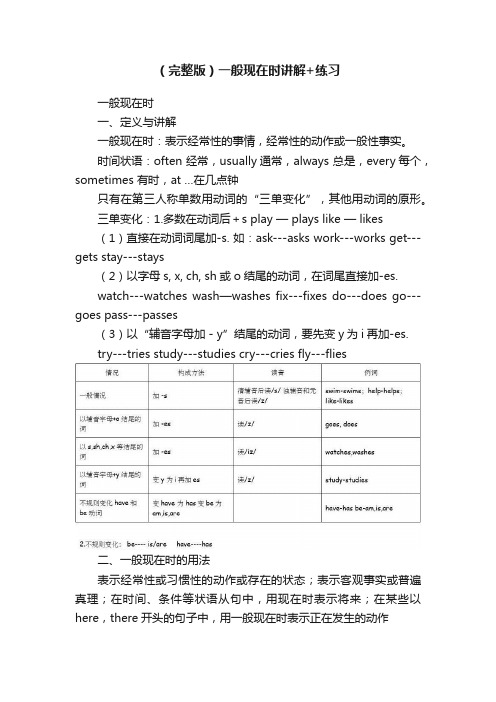
(完整版)一般现在时讲解+练习一般现在时一、定义与讲解一般现在时:表示经常性的事情,经常性的动作或一般性事实。
时间状语:often 经常,usually通常,always 总是,every每个,sometimes 有时,at …在几点钟只有在第三人称单数用动词的“三单变化”,其他用动词的原形。
三单变化:1.多数在动词后+s play — plays like — likes(1)直接在动词词尾加-s. 如:ask---asks work---works get---gets stay---stays(2)以字母s, x, ch, sh或o结尾的动词,在词尾直接加-es.watch---watches wash—washes fix---fixes do---does go---goes pass---passes(3)以“辅音字母加 - y”结尾的动词,要先变y为i再加-es.try---tries study---studies cry---cries fly---flies二、一般现在时的用法表示经常性或习惯性的动作或存在的状态;表示客观事实或普遍真理;在时间、条件等状语从句中,用现在时表示将来;在某些以here,there开头的句子中,用一般现在时表示正在发生的动作当主语是第三人称单数时:1、动词变相应的第三人称单数形式2、肯定句主语+动词s+其它3、否定句主语+doesn't+动词原形+其它4、一般疑问句Does+主语+动词原形+其它5、肯定回答 Yes,主语+does6、否定回答 No,主语+doesn't7、特殊疑问句特殊疑问词+一般疑问句当主语不是第三人称单数时:1、肯定句主语+动词原形+其它2、否定句主语+don't+动词原形+其它3、一般疑问句 Do+主语+动词原形+其它4、要注意,句式结构错则全都错。
5、谓语动词的形式:do/does一般现在时练习一、用所给词的正确形式填空1. We often ___________ (play) on the playground.2. He _________ (get) up at six o’clock.3. __________you _________ (brush) your teeth every morning.4. What____ (do) he usually _____ (do) after school?5. Danny _______ (study) English, Chinese, Math, Science and Art at school.6. Mike sometimes __________ (go) to the park with his sister.7. At eight at night, she ________ (watch) TV with his parents.8. ________ Mike________ (read) English every day?9. How many lessons ______your classmate____ (have) on Monday?10. What time ____his mother_________ (do) the housework?11. He often ______ (have) dinner at home. 12. Daniel and Tommy___ (be) in Class One. 13. We____ (not watch) TV on Monday. 14. Nick _____(not go) to the zoo on Sunday.15. They______ (like) the World Cup? 16. What ____they often ____ (do) on Saturdays17. Your parents________ (read) newspapers every day?18. The girl______ (teach) us English on Sundays.19. She and I _______ (take) a walk together every evening.20. There_______ (be) some water in the bottle. 21. Mike ______ (like) cooking.22. They_______ (have) the same hobby. 23. My aunt______ (look) after her baby carefully.24. You always____ (do) your homework well. 25. I_____ (be) ill. I’m sta ying in bed.26. She_____ (go) to school from Monday to Friday. 27. Liu Tao _____ (do) not like PE.28. The child often______ (watch) TV in the evening.29. Su Hai and Su Yang ______(have) eight lessons this term.30. -What day ______(be) it today? -It’s Saturday.31. Don’t make a noise. Grandpa __________ (sleep).32. Tom’s family__________ (watch) TV.33. It ________ (take) me two hours to finish my homework last night.34. What ______ your mother _______ (do) every evening? She_______ (wash) clothes.35. _______ it ______ (rain) every day?36. What _______ (do) you _______ on Sundays? We ________ (play) football.37. There ________ (be) a football match on TV every morning.38. They often ________ (visit) the Great Wall.39. Who _______ (dance) the best in your class?40. He _____________ (not come).41. The earth __________ (move) round the sun.42 She ________ (buy) a sweater.43. Mr. Wang often______ (go) to Shanghai.二、改句子1. Do you often play football after school? (肯定回答)_______________________________2. I have many books. (改为否定句)_______________________________3. Gao Shan's sister likes playing table tennis (改为否定句)________________________4. She lives in a small town near New York. (改为一般疑问句)________________________5. I watch TV every day. (改为一般疑问句)________________________6. David has a goal. (改为一般疑问句)________________________7. We have four lessons.(否定句)________________________8. Nancy doesn’t run fast (肯定句)________________________9. My dog runs fast. (一般疑问句) ________________________(把10—14小题变否定句,一般疑问句和划线提问)10. Mike has two letters for him. ________________________11. I usually play football on Friday afternoon.________________________12. Su Yang usually washes some clothes on Saturday. ________________________13. Mingming usually waters the flowers every day. ________________________14. Tom does his homework at home. ________________________三、写出下列动词的第三人称单数形式:1. wash_________ match _______ guess______ study______finish_________ go________ snow______ carry_________2. stop______ see________ drive ________let_______ carry______keep_____ join______ find_______ think________ teach______ catch______3. stay_______ begin______ forget_______ lie________ die _______run_______ prefer______ give________ ring_______ dance______ hope_______四、单项选择:1. There _____ an English film at the cinema now.A. will haveB. is going to haveC. is going to beD. is2. The picture _______ nice. A. looks B. is looked C. look D. is looking3. She ______ down and soon falls asleep. A. live B. lain C. laidD. sits4. They _____ the office in time very morning. A. reach to B. arrived C. went D. get to5. We shall go to Shanghai on business before you _____ back next week.A. will comeB. cameC. would comeD. come6. The plane ______ over there. A. is B. are C.am D. was7. I see her ____ the room this morning. A. to enter B. enteredC. enterD. enters8. The teacher ________us to come to school on time. A. ask B. asking C. asks D. asked9. John always ______ others. A. help B. helping C. helps D. to help10. He ______for eight hours every day. A. working B. to workC. worksD. worked11. You’d better ______ at home and ______ your homework.A. to stay, doB. stay, doC. to stay, to doD. stay, to do12. He sits down and ______ a rest. A. having B. have C. to haveD. has13. Uncle Wang never ______ a cake. A. make B. to make C. making D. makes五、请写出下列句子1.他每天早上七点乘公交车去上学。
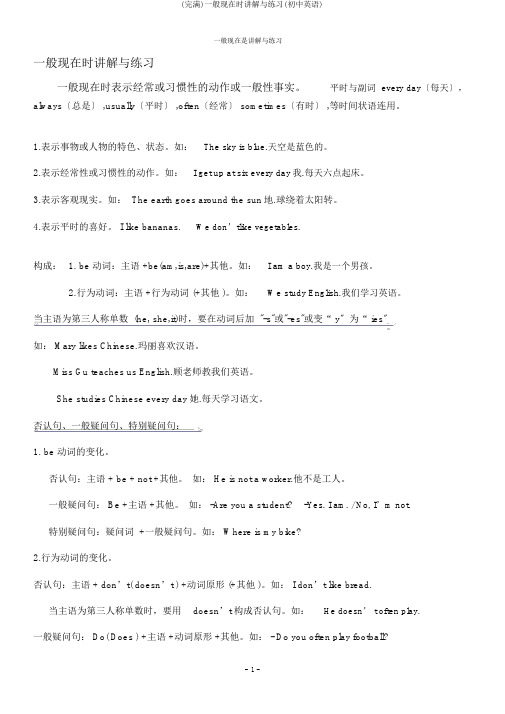
一般现在是讲解与练习一般现在时讲解与练习一般现在时表示经常或习惯性的动作或一般性事实。
平时与副词 every day〔每天〕,always〔总是〕 ,usually〔平时〕 ,often〔经常〕 sometimes〔有时〕 ,等时间状语连用。
1.表示事物或人物的特色、状态。
如:The sky is blue.天空是蓝色的。
2.表示经常性或习惯性的动作。
如:I get up at six every day我.每天六点起床。
3.表示客观现实。
如: The earth goes around the sun地.球绕着太阳转。
4.表示平时的喜好。
I like bananas.We don’tlike vegetables.构成: 1. be 动词:主语 +be(am,is,are)+其他。
如:I am a boy.我是一个男孩。
2.行为动词:主语 +行为动词 (+其他 )。
如:We study English.我们学习英语。
当主语为第三人称单数 (he, she,it)时,要在动词后加 "-s"或"-es"或变“ y〞为“ ies〞如: Mary likes Chinese.玛丽喜欢汉语。
Miss Gu teaches us English.顾老师教我们英语。
She studies Chinese every day她.每天学习语文。
否认句、一般疑问句、特别疑问句:1. be 动词的变化。
否认句:主语 + be + not +其他。
如: He is not a worker.他不是工人。
一般疑问句: Be +主语 +其他。
如: -Are you a student?-Yes. I am. / No, I’m not.特别疑问句:疑问词 +一般疑问句。
如: Where is my bike?2.行为动词的变化。
否认句:主语 + don’t( doesn’t ) +动词原形 (+其他 )。
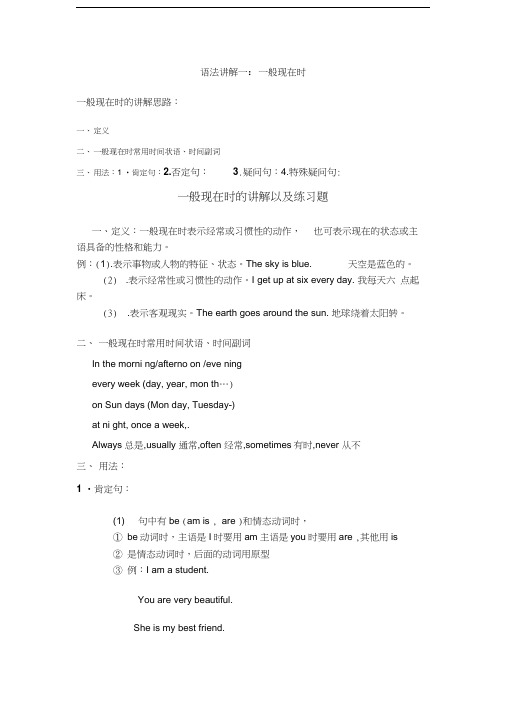
语法讲解一:一般现在时一般现在时的讲解思路:一、定义二、一般现在时常用时间状语、时间副词三、用法:1 •肯定句:2.否定句:3.疑问句:4.特殊疑问句:一般现在时的讲解以及练习题一、定义:一般现在时表示经常或习惯性的动作,也可表示现在的状态或主语具备的性格和能力。
例:(1).表示事物或人物的特征、状态。
The sky is blue. 天空是蓝色的。
(2).表示经常性或习惯性的动作。
I get up at six every day. 我每天六点起床。
(3).表示客观现实。
The earth goes around the sun. 地球绕着太阳转。
二、一般现在时常用时间状语、时间副词In the morni ng/afterno on /eve ningevery week (day, year, mon th…)on Sun days (Mon day, Tuesday-)at ni ght, once a week,.Always 总是,usually 通常,often 经常,sometimes有时,never 从不三、用法:1 •肯定句:(1) 句中有be (am is , are )和情态动词时,①be动词时,主语是I时要用am主语是you时要用are ,其他用is②是情态动词时,后面的动词用原型③例:I am a student.You are very beautiful.She is my best friend.He can do his homework by himself(2)没有be (am is, are )动词和情态动词:主语为第三人称单数(she ,he ,it )、单数可数名词、不可数名词的,动词要按规则加上s或es;主语是复数可数名词的肯定句,动词用原形。
例:①She(He, It )likes fish. 她(他,它)喜欢鱼。
(主语为第三人称单数②The table has four legs.桌子有四条腿。

一、教学目标1. 知识目标:了解一般现在时的概念、构成和用法。
2. 技能目标:能够正确运用一般现在时进行表达,并能够辨别一般现在时与其他时态的区别。
3. 情感目标:激发学生学习英语的兴趣,培养良好的学习习惯。
二、教学重难点1. 教学重点:一般现在时的构成、用法以及与过去时、将来时的区别。
2. 教学难点:一般现在时中动词的变化形式,以及句型结构的运用。
三、教学过程(一)导入1. 教师通过展示一些日常生活中的图片或视频,引导学生思考这些场景中的人物正在做什么。
2. 学生分享自己观察到的内容,教师总结:这些动作都是经常发生的,我们可以用一般现在时来描述。
(二)新课导入1. 教师介绍一般现在时的概念:一般现在时用来描述经常性、习惯性的动作或存在的状态。
2. 教师讲解一般现在时的构成:主语 + 动词原形。
3. 教师展示一般现在时中动词的变化规则,并举例说明。
(三)课堂活动1. 学生练习:教师给出一些句子,让学生判断句子中的动词是否属于一般现在时,并说明理由。
2. 学生练习:教师给出一些动词,让学生根据动词的词尾变化规则,写出相应的动词原形。
3. 学生练习:教师给出一些句型,让学生根据句型要求,构造一般现在时的句子。
(四)巩固练习1. 教师组织学生进行角色扮演,用一般现在时描述场景中人物的动作。
2. 学生分组,每组选择一个主题,用一般现在时编写一段对话。
(五)课堂小结1. 教师总结一般现在时的构成、用法以及与过去时、将来时的区别。
2. 学生分享自己在课堂上的收获,教师给予点评和鼓励。
四、课后作业1. 完成课后练习题,巩固一般现在时的知识。
2. 收集生活中的一般现在时句子,下节课与同学分享。
五、教学反思1. 教师在教学中要注意引导学生积极参与,提高学生的学习兴趣。
2. 注重学生的实际运用能力,让学生在课堂上充分练习。
3. 关注学生的个体差异,给予不同层次的学生适当的指导。

一般现在时标准教案一、教学目标1. 让学生掌握一般现在时的概念和用法。
2. 能够正确运用一般现在时描述经常性和习惯性的动作、状态和特征。
3. 学会使用一般现在时的be动词和行为动词。
4. 能够听懂、说出一般现在时的句子。
二、教学内容1. 一般现在时的概念和用法。
2. be动词(am, is, are)的用法。
3. 行为动词(have, do, go, e, leave, arrive, eat, drink, sleep, read, write, listen, speak, etc.)的用法。
三、教学重点1. 一般现在时的结构:主语+ be动词+ 表语;主语+ 行为动词+ 宾语。
2. be动词的用法和辨析。
3. 行为动词的用法和辨析。
四、教学难点1. be动词在一般现在时的用法,特别是在主语为第三人称单数时。
2. 行为动词在一般现在时的用法,特别是在描述经常性和习惯性的动作、状态和特征时。
五、教学方法1. 任务型教学法:通过小组合作、角色扮演等活动,让学生在实际语境中运用一般现在时。
2. 情境教学法:创设生活情境,让学生在真实环境中感受和理解一般现在时。
3. 游戏教学法:设计趣味游戏,激发学生的学习兴趣,提高学生的参与度。
六、教学准备1. 教学PPT或黑板。
2. 教学卡片或图片。
3. 练习册和作业本。
4. 录音机或播放器。
5. 教学游戏材料。
七、教学过程1. 导入:通过歌曲、游戏或日常对话引入一般现在时的话题。
2. 呈现:用PPT、卡片或图片展示一般现在时的结构和相关词汇。
3. 讲解:讲解一般现在时的概念、用法和be动词、行为动词的辨析。
4. 练习:分组练习,让学生用一般现在时描述自己和同学的特征、习惯和动作。
5. 互动:学生之间进行对话,运用一般现在时进行交流。
6. 巩固:通过游戏、竞赛等活动巩固所学内容。
八、课堂作业1. 用一般现在时完成句子:I ____________________ (read) a book.She ____________________ (have) lunch at 12 o'clock.They ____________________ (go) to school bus.2. 编写一段对话,运用一般现在时描述日常生活中的事情。
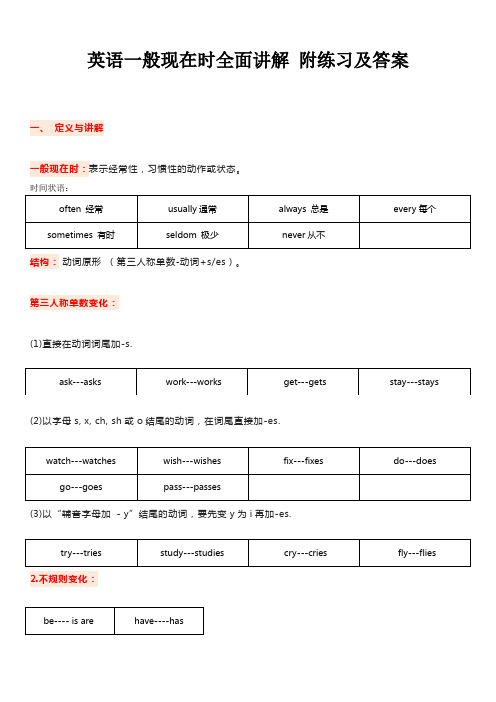
英语一般现在时全面讲解附练习及答案一、定义与讲解一般现在时:表示经常性,习惯性的动作或状态。
结构:动词原形(第三人称单数-动词+s/es)。
第三人称单数变化:(1)直接在动词词尾加-s.(2)以字母s, x, ch, sh或o结尾的动词,在词尾直接加-es.(3)以“辅音字母加- y”结尾的动词,要先变y为i再加-es.2.不规则变化:二、一般现在时用法1. 表示经常性,习惯性,永久性的动作或存在的状态.通常与副词sometimes, often, usually, always, every day (year, month ), once (twice, three times) a day,等时间状语连用。
2. 表示客观真理,科学原理,自然现象,等客观事实或格言,谚语等。
三、一般现在时的句子转换:(1)当句子中有be动词或情态动词时,则把be动词或情态动词(can,could等等)提到主语的前面变成疑问句;在be动词或情态动词后面加not变成否定句.(2)当句子中即没有be动词,也没有情态动词时,则在主语前加助动词do (you,以及复数), does(单数she,he,it)变成问句;在主语后谓语动词前加助动词don’t(I,you,以及复数), doesn’t(单数she,he,it)变成否定句,助动词后的动词要变成动词原形。
名师解析1.________ you often ________ tea?A.Do;drinks B.Does;drink C.Do;drink分析:你经常喝茶吗?根据often可知句子为一般现在时,主语为you,用助动词Do提问,动词用原形,C 符合题意,故选C。
2.My legs .A.hurt B.hurts C.hurting分析:我的腿……。
A痛,动词原形;B痛,动词单三形式,主语是名词复数,谓语动词用原形,排除;C痛,现在分词,用于现在进行时,构成be doing,缺少be,排除。
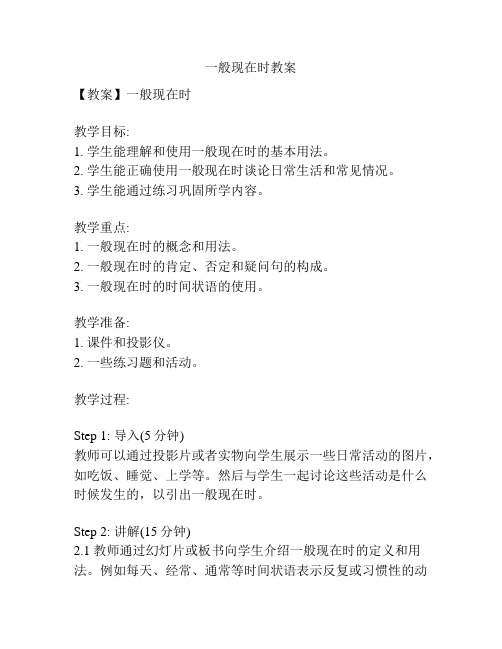
一般现在时教案【教案】一般现在时教学目标:1. 学生能理解和使用一般现在时的基本用法。
2. 学生能正确使用一般现在时谈论日常生活和常见情况。
3. 学生能通过练习巩固所学内容。
教学重点:1. 一般现在时的概念和用法。
2. 一般现在时的肯定、否定和疑问句的构成。
3. 一般现在时的时间状语的使用。
教学准备:1. 课件和投影仪。
2. 一些练习题和活动。
教学过程:Step 1: 导入(5分钟)教师可以通过投影片或者实物向学生展示一些日常活动的图片,如吃饭、睡觉、上学等。
然后与学生一起讨论这些活动是什么时候发生的,以引出一般现在时。
Step 2: 讲解(15分钟)2.1 教师通过幻灯片或板书向学生介绍一般现在时的定义和用法。
例如每天、经常、通常等时间状语表示反复或习惯性的动作或状态。
2.2 教师向学生解释一般现在时的肯定、否定和疑问句的构成规则,并通过例句进行示范。
Step 3: 练习(20分钟)3.1 利用教材中的练习题让学生进行练习,巩固所学内容。
3.2 通过游戏或小组活动的形式,让学生互相提问和回答关于日常生活的问题,以练习一般现在时的用法。
Step 4: 拓展(10分钟)4.1 教师可以向学生展示一些包含一般现在时的实际应用场景,如日记、个人介绍等。
并引导学生在这些场景中运用一般现在时进行表达。
4.2 教师鼓励学生运用所学的一般现在时进行口头表达,并提供相关的话题进行讨论。
Step 5: 总结(5分钟)教师通过回顾一般现在时的定义、用法和构成规则,让学生对本节课所学的内容进行总结。
Step 6: 作业布置(5分钟)布置作业,要求学生根据所给的情境写一篇关于自己日常生活的文章,要求用到一般现在时。
Step 7: 课堂小结(5分钟)对学生的表现进行总结评价,并回答学生的问题。
教学反思:本节课主要通过简单的导入和讲解,帮助学生理解和掌握一般现在时的基本用法,然后通过练习和活动巩固所学内容,并鼓励学生进行口头表达。

第1篇教学目标:1. 学生能够正确理解一般现在时的概念和用法。
2. 学生能够熟练运用一般现在时态来表达习惯性、普遍性、客观真理等概念。
3. 学生能够通过阅读、写作和口语练习,提高运用一般现在时态的能力。
教学重点:1. 一般现在时的构成和用法。
2. 一般现在时在句子中的具体应用。
教学难点:1. 一般现在时与现在进行时、一般将来时等时态的区别。
2. 一般现在时在特定语境下的用法。
教学准备:1. PPT课件:一般现在时的构成、用法和例句。
2. 练习题:一般现在时的判断题、改错题、翻译题等。
3. 小组活动材料。
教学过程:一、导入1. 通过展示图片或视频,引导学生思考:图片或视频中的人物正在做什么?为什么他们这么做?2. 引导学生总结出一般现在时可以用来描述习惯性、普遍性、客观真理等概念。
二、讲解1. 讲解一般现在时的构成:主语+谓语动词原形。
2. 举例说明一般现在时的用法:a. 描述习惯性动作:I usually get up at 7:00 a.m.b. 描述普遍真理:The earth is round.c. 描述客观事实:She is a teacher.3. 讲解一般现在时与现在进行时、一般将来时的区别:a. 一般现在时表示经常性、习惯性动作,现在进行时表示正在进行的动作,一般将来时表示将要发生的动作。
b. 举例说明区别:I eat breakfast every morning.(一般现在时)I am eating breakfast now.(现在进行时)I will eat breakfast tomorrow.(一般将来时)三、练习1. 进行一般现在时的判断题练习,巩固学生对一般现在时的理解。
2. 进行一般现在时的改错题练习,提高学生对一般现在时用法的准确性。
3. 进行一般现在时的翻译题练习,锻炼学生的语言运用能力。
四、小组活动1. 将学生分成小组,每组选择一个话题,用一般现在时进行讨论。
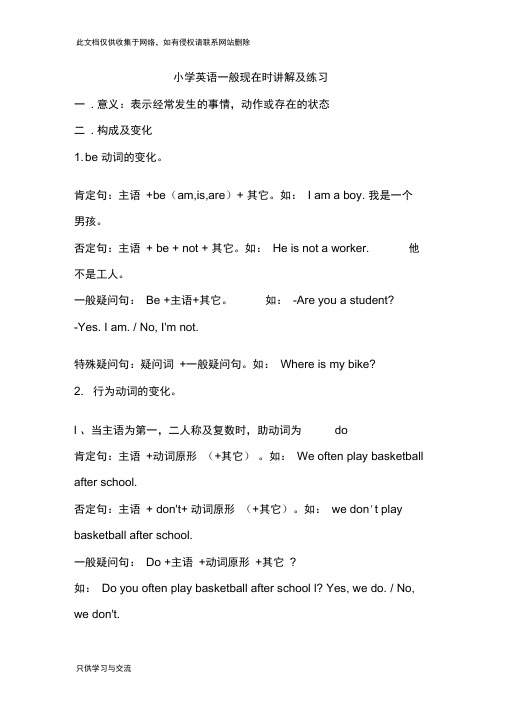

一般现在时I: The Present Simple Tense 一般现在时表示经常发生的动作或经常存在的状态.常和 always, often, usually, every day, sometimes等表示时间的状语连用.动词be:除第一人称单数(I)用am,第三人称单数用is外,其余一律用are.行为动词:除第三人称单数做主语时由动词原形加词尾-s或-es外,其余一律用动词原形.现将动词be, 和行为动词(以know为例)在肯定、否定、一般疑问和简略回答中的形式列表如下:表一动词肯定否定be I am …You are …He /She/It is …We /You/They are …I am not …You are not …He /She/It is not …We /You/They are not…行为动词know I /You know …He /She/It knows …We /You/They know …I /You do not know …He /She/It does not knows …We /You/They do not know …表二动词一般疑问简略回答be Are you …?Is he …?Are they …?Yes, I am.No, I am not.Yes, we are.No, we are not.Yes, he is.No, he is not.Yes, they are.No, they are not.行为动词know Do you know …?Does he know …?Do they know …?Yes, I do.No, I do not.Yes, we do.No, we do not.Yes, he does.No, he does not.Yes, they do.No, they don’t.练习:请写出以上两句的一般疑问句和简略回答。
简略式:is not = isn’t are not = aren’t do not = don’t does not = doesn’t但am not 无简略式,不能写成amn’t第三人称单数形式的词尾变化如下:在一般现在时中, 当主语是第三人称单数时, 行为动词用第三人称单数形式, 即加 -s 或–es 的形式. 具体方法如下:1.一般情况下,直接加 -seg. works, plays, rains, sees2.以 sh, ch, s, x 或 o 结尾的词后加–eseg. washes, teaches, fixes, does, goes3.以辅音字母加 -y 结尾的,先把‘y’ 改成‘i’, 再加 -eseg. studies, flies, carries注意:动词加 -s 以后的读音.动词加-s后的读音1.在[p] [t] [k] [f] 等清辅音后,发清辅音 /s/eg. helps , works, likes, hates ,laughs2.在浊辅音和元音后,发浊辅音 /z/eg. drives, cleans, plays3.在[s] [z] [∫ ] [ ] [ ]后,发 /iz/rises, wishes, teaches, urges4.在[t] [d]后,发/ts/ /dz/eg. fits, sets, needs5. 其他情况下发[z]eg. plans, cries, shows一般现在时的主要用法:1.表示经常发生的动作、存在的状态或日常的习惯,常与every day, often, alwayssometimes 等时间状语连用。
eg. She gets up at six every day.She is our teacher of English.We go there once a week.2.表示主语的特征、性格、能力等。
eg. Tom studies very hard.She is always ready to help others.I major in English.3.表示客观事实或普遍真理。
eg. The sun rises in the east and sets in the west.The water boils at 100℃.Actions speaks louder than words. 行动胜于言辞。
(谚语)4.在故事和叙事中,为了生动活泼的需要。
5.新闻标题或小说章节的题目。
Bank Robbery :Robbers take $ 1,000,000.标银行抢劫案:匪徒抢走1000000美元。
练习:将下列问句变为否定句1) They meet at the party.2) She works in a school.将下列句子变为一般问句,并作出肯定、否定回答。
She comes from Australia.特殊疑问句:就句中某一部分提问的疑问句叫作特殊疑问句. 它一般是以WH开始的疑问句,也可以叫WH的question。
特殊疑问句的构成是:疑问词+ 一般疑问句(提问主语或主语的一部分时除外)回答时,要根据具体情况进行回答.主要疑问词有:who, whose, whom, what, which, when, where, why, how等.eg. Where is he from? He is from China.When do you work? I work in the morning.What does he like? He likes English.Who teaches you English? Mr. Wang.Which c oat is John’s? The blue one.Why isn’t she here? Because she is ill.How old are you? Twenty-one.Who (Whom) do you help? I help my sister.Note:whom 是 who 的宾格形式, 现已逐渐被who所取代. 但正式文体中仍使用 whom.What’s your name?What country are you from?II:人称代词(主格和宾格)、物主代词数主格宾格形容词性物主代词名词性物主代词单数一I me my mine 二you you your yours三he him his hisshe her her hersit it its ---复数一we us our ours 二you you your yours三they them their theirs 人称代词作主语时用主格,作宾语时用宾格。
eg. They all like him very much.作表语时,用宾格时较多,特别是在口语中。
eg. Who is knocking at the door? -------It’s me.但在下列结构中却常用主格:It was he who did it. It is she who wants it.使用人称代词要注意:1.we, you they有时用来泛指一般的人,翻译时一定要注意。
We (You) should keep calm even when we (you) are in danger.They don’t allow us to smoke here.第一句译文:即使在危急时刻也要保持冷静。
第二句译文:这儿不许抽烟。
2.在写文章或是做报告时,人们常以we来称自己,而不用I,这样口气显得谦虚一些。
3.She 可以用来代表国家、船只、大地、月亮等。
eg. The aircraft carrier-“Minsk” belongs to China, doesn’t she?4. 在并列的主语中,I 总放最后。
eg. Xiao Yu and I are in charge of the work.练习:用正确的人称代词填空:1) _____(James) works with ____ (my friend and I) . ____ (Peter and Kate) ask ____ (Katherine) about Dubline.2) 给出一个family tree, 请利用所学的人称代词说出他们的关系。
John Robinson (H)Mary Robinson (W)Peter(H)Susan (W)Kate(H) Paul(W)MaryPhilip一般现在时用法专练:一、写出下列动词的第三人称单数drink ________ go _______ stay ________ make ________look _________ have_______ pass_______ carry ____come________ watch______ plant_______ fly ________study_______ brush________ do_________ teach_______wash_______二、用括号内动词的适当形式填空。
1. He often ________(have) dinner at home.2. Daniel and Tommy _______(be) in Class One.3. We _______(not watch) TV on Monday.4. Nick _______(not go) to the zoo on Sunday.5. ______ they ________(like) the World Cup?6. What _______they often _______(do) on Saturdays?7. _______ your parents _______(read) newspapers every day?8. The girl _______(teach) us English on Sundays.9. She and I ________(take) a walk together every evening.10. There ________(be) some water in the bottle.11. Mike _______(like) cooking.12. They _______(have) the same hobby.13. My aunt _______(look) after her baby carefully.14. You always _______(do) your homework well.15. I _______(be) ill. I’m staying in bed.16. She _______(go) to school from Monday to Friday.17. Liu Tao _______(do) not like PE.18. The child often _______(watch) TV in the evening.19. Su Hai and Su Yang _______(have) eight lessons this term.20. -What day _______(be) it today?-It’s Saturday三、按照要求改写句子。